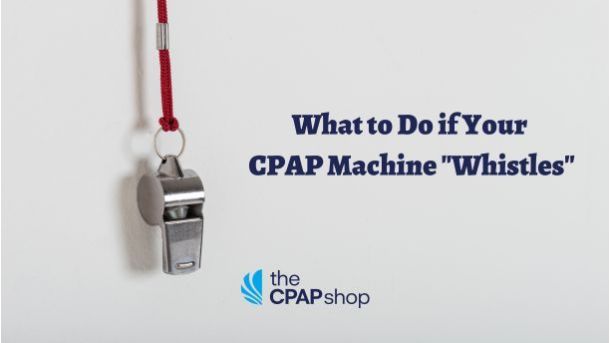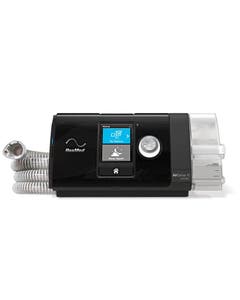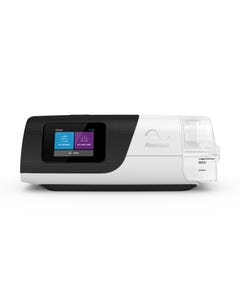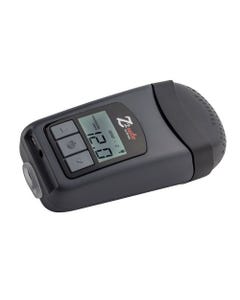Why Is My CPAP Machine Whistling? Here’s How To Fix It!
This post was originally posted on May 27, 2018, and updated on February 28, 2022.
The leading form of treatment for people suffering from obstructive sleep apnea (OSA) is continuous positive airway pressure or CPAP therapy. A CPAP machine uses a hose and mask to deliver a constant flow of pressured air to keep the airway open throughout the night and reduce apnea episodes. Some CPAP users have encountered what has been described as a very slight whistling noise when they use their machine. Here’s how to solve that problem.
Check The Fit of Your CPAP Mask
Disconnect your CPAP mask from the hose while leaving your CPAP machine on and the hose connected. If the whistle goes away, then a poorly fitting mask might be the issue. Try adjusting your mask until you no longer hear the noise. If that doesn’t work, it may be time to find a new mask.
Check the Hose Connection
Another possible reason for whistling is that the hose is not properly connected to the CPAP machine. Try readjusting the hose connection at the machine end. If you notice that you are able to stop the whistling by holding the hose tightly to the machine, yet still hear the noise when you let go, then it’s time for a new hose. Hoses can get stretched out over time and develop leaks around their point of connection.
Check for Other Hose Problems
Most likely any whistling is due to problems with the hose. Look for holes in the hose that might be letting air leak out. Submerge your hose in water and let it fill up. Plug both ends of the hose and take it out of the water. If there are holes, water will leak out from them.
Also, look for cracked or dried up sections of the hose or mineral deposits. All hoses wear out over time. Whistling may be a sign that it’s time for a hose replacement.
Quieter CPAP Machines
If noise other than whistling is keeping you (or your bed partner) up at night, then you may want to look for a CPAP machine with quieter performance.
We recommend:
ResMed AirSense 10 AutoSet CPAP Machine with Heated Humidifier
The ResMed AirSense 10 features an Easy-Breathe motor. Foam and insulation have been added to the base of the CPAP machine to reduce noise. This also helps minimize turbulence and improve performance.
The Resvent iBreeze comes with an integrated humidifier that helps users breathe easily during effective CPAP therapy. Moreover, the machine has a 3.5-inch screen that allows easy menu navigation and detailed data on sleep apnea therapy.
Looking for a quiet CPAP machine or need more help with a whistling machine? Give us a call at 866.414.9700 or email our team at questions@thecpapshop.com. Find more CPAP machines and supplies at https://www.thecpapshop.com.
Chris Vasta is the president of The CPAP Shop and an expert in sleep and respiratory therapy. He often provides insights on product design and functionality on various manufacturers’ prototypes and is frequently tapped to provide reviews on new releases.
The leading form of treatment for people suffering from obstructive sleep apnea (OSA) is continuous positive airway pressure or CPAP therapy. A CPAP machine uses a hose and mask to deliver a constant flow of pressured air to keep the airway open throughout the night and reduce apnea episodes. Some CPAP users have encountered what has been described as a very slight whistling noise when they use their machines. Here’s how to solve that problem.
What Does a CPAP Machine Sound Like?
The sound of a CPAP machine is often referred to continuous and comfortable white nose. The sound coming from a CPAP machine is dependent on the model you have. While some machines are quieter than others, CPAP machines on average operate at a sound level of 30 dBa, which is comparable to quiet whispers in a library. This sound level might be bothersome to light sleepers, but overall it should not interfere with your sleep.
What Causes a CPAP Machine to Whistle?
Check The Fit of Your CPAP Mask
- Incorrect Mask Style or Fit
- A CPAP mask that fits properly is crucial to overall CPAP success. If you are hearing a whistling noise, try adjusting your CPAP mask's fit. That could be the cause of it.
- Make sure your mask is not too snug, as that will leave red marks on your face, but also not too loose, as that may be the cause of the whistling noise. Try adjusting your mask until you no longer hear the noise. If that doesn’t work, it may be time to find a new mask.
- If you have adjusted your mask correctly, and the whistling noise is no longer there, you will be less disturbed and more comfortable sleeping at night. More comfort during CPAP therapy results in better compliance and CPAP success.
- Poor Mask Seal
- Making sure you have a proper mask seal is also very important to having better CPAP treatment each night. If your mask cushion is not properly in place, you may notice that you are having mask leaks.
- If this is happening, it may be time to replace your mask cushion. Cushions should be replaced every 30 days to ensure the best seal. If you are using a mask without the best seal, you are impacting your therapy effectiveness, comfort, and overall sleep quality.
Disconnect your CPAP mask from the hose while leaving your CPAP machine on and the hose connected. If the whistle goes away, then a poorly fitting mask might be the issue. Try adjusting your mask until you no longer hear the noise. If that doesn’t work, it may be time to find a new mask.
Check the Hose Connection
- Loose or Disconnected Tubing Connections
- A hissing sound is a telltale sign that the tube is loose or not installed correctly. This will impact your therapy and may even cause discomfort as well.
-
Try readjusting the hose connection at the machine end. If you notice that you can stop the whistling by holding the hose tightly to the machine, yet still hear the noise when you let go, then it’s time for a new hose. Hoses can get stretched out over time and develop leaks around their point of connection.
- If your CPAP hose is damaged in any way by cracks, this will also result in a whistling or hissing noise. If you notice your tube is old and/or damaged, replace it immediately so that the problem does not persist.
Another possible reason for whistling is that the hose is not properly connected to the CPAP machine. Try readjusting the hose connection at the machine end. If you notice that you are able to stop the whistling by holding the hose tightly to the machine, yet still hear the noise when you let go, then it’s time for a new hose. Hoses can get stretched out over time and develop leaks around their point of connection.
Check for Other Hose Problems
- Kinks or Bends in the Tubing
- If your tubing has any kinks or bends in it, your airflow will be disrupted, resulting in a weakened pressure delivery.
- The kinks and bends will also impact noise levels and may disrupt you while you are sleeping.
- Look for holes in the hose that might be letting air leak out. Submerge your hose in water and let it fill up. Plug both ends of the hose and take it out of the water. If there are holes, water will leak out from them.
Most likely any whistling is due to problems with the hose. Look for holes in the hose that might be letting air leak out. Submerge your hose in water and let it fill up. Plug both ends of the hose and take it out of the water. If there are holes, water will leak out from them.
Also, look for cracked or dried up sections of the hose or mineral deposits. All hoses wear out over time. Whistling may be a sign that it’s time for a hose replacement.
Check on the Humidifier
- Water Level Concerns
- Condensation could occur in both the tubing and humidifier from the heated moisture being delivered to the CPAP patients or if the items are old and worn out.
- To address this problem, it is recommended to adjust the humidifier settings to a level that prevents condensation buildup while still providing necessary moisture for comfort during CPAP therapy.
- Regularly checking and adjusting the humidifier settings is crucial to maintaining an optimal balance for a more comfortable and effective CPAP experience.
Quieter CPAP Machines
If noise other than whistling is keeping you (or your bed partner) up at night, then you may want to look for a CPAP machine with a quieter performance. We recommend:
ResMed AirSense 10 AutoSet CPAP Machine Card-to-Cloud
The ResMed AirSense 10 AutoSet CPAP Machine Card-to-Cloud is a powerful and effective CPAP machine that is very similar to its predecessor and popular machine, the AirSense 10. The Card-to-Cloud device includes all the same features as the original AirSense 10 but without cellular connectivity. Instead, this machine uses an SD card to store sleep data that doctors can then retrieve from the SD card.
The ResMed AirSense 10 features an Easy-Breathe motor. Foam and insulation have been added to the base of the CPAP machine to reduce noise. This also helps minimize turbulence and improve performance. This machine operates at 30 dBa, which is equivalent to the sound of a whisper nearby. As this machine operates and quietly sits on a person's nightstand, they and their bed partner can have a peaceful night's sleep.
ResMed AirSense 11 AutoSet CPAP Machine
The ResMed AirSense 11 AutoSet CPAP Machine offers a sleek design and advanced technology that provides the user with a wide range of the latest features that ensure an ideal sleep apnea therapy. It comes with an integrated humidifier that helps users breathe easily during effective CPAP therapy. Additionally, this machine comes with digital health technology that helps to provide effective CPAP therapy.
The AirSense 11 is also equipped with an easy breath motor that creates a suitable sleep environment. It operates at a noise level of 27 dBa, which is very faint and quieter than the average machine. The quiet design is ideal for those who are light sleepers or have bed partners as it provides a quiet environment for sleeping.
Breas Z2 Auto Travel CPAP Machine
The Breas Z2 Auto Travel CPAP Machine is a travel device that offers patients effective CPAP therapy even while they are traveling or on the go. This device is a quieter version of its predecessor, Z1 CPAP, with additional improved features, an auto start & stop button, and an algorithm for comfortable CPAP therapy. The addition of Q-Tube to the Breas Z2 CPAP machine ensures lower noise levels even at higher pressures, operating at a noise level of 26 dBa.
Conclusion
As mentioned above, your CPAP machine could be whistling for several reasons, including an improper mask fit, loose hose connection, worn-out products, and more. If you notice your machine is making a whistling noise, addressing the issue as soon as you notice it is recommended. Fixing the issue promptly will avoid any interruption in your therapy and will ensure a peaceful night's sleep.
Looking for a quiet CPAP machine or need more help with a whistling machine? Give us a call at 866.414.9700 or email our team at questions@thecpapshop.com. Find more CPAP machines and supplies on our website.
This post was originally posted on May 27, 2018, and updated on February 21, 2024.







